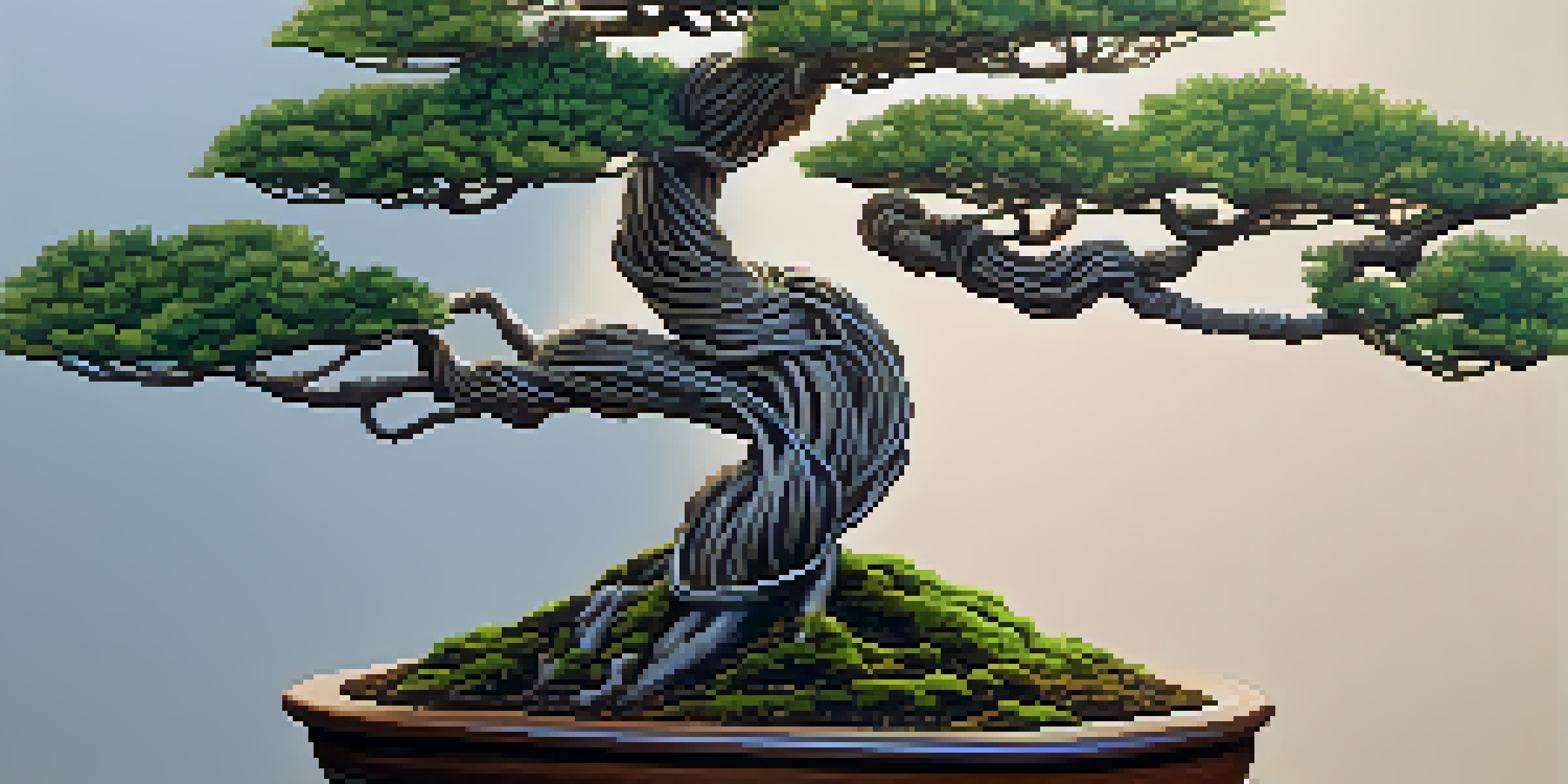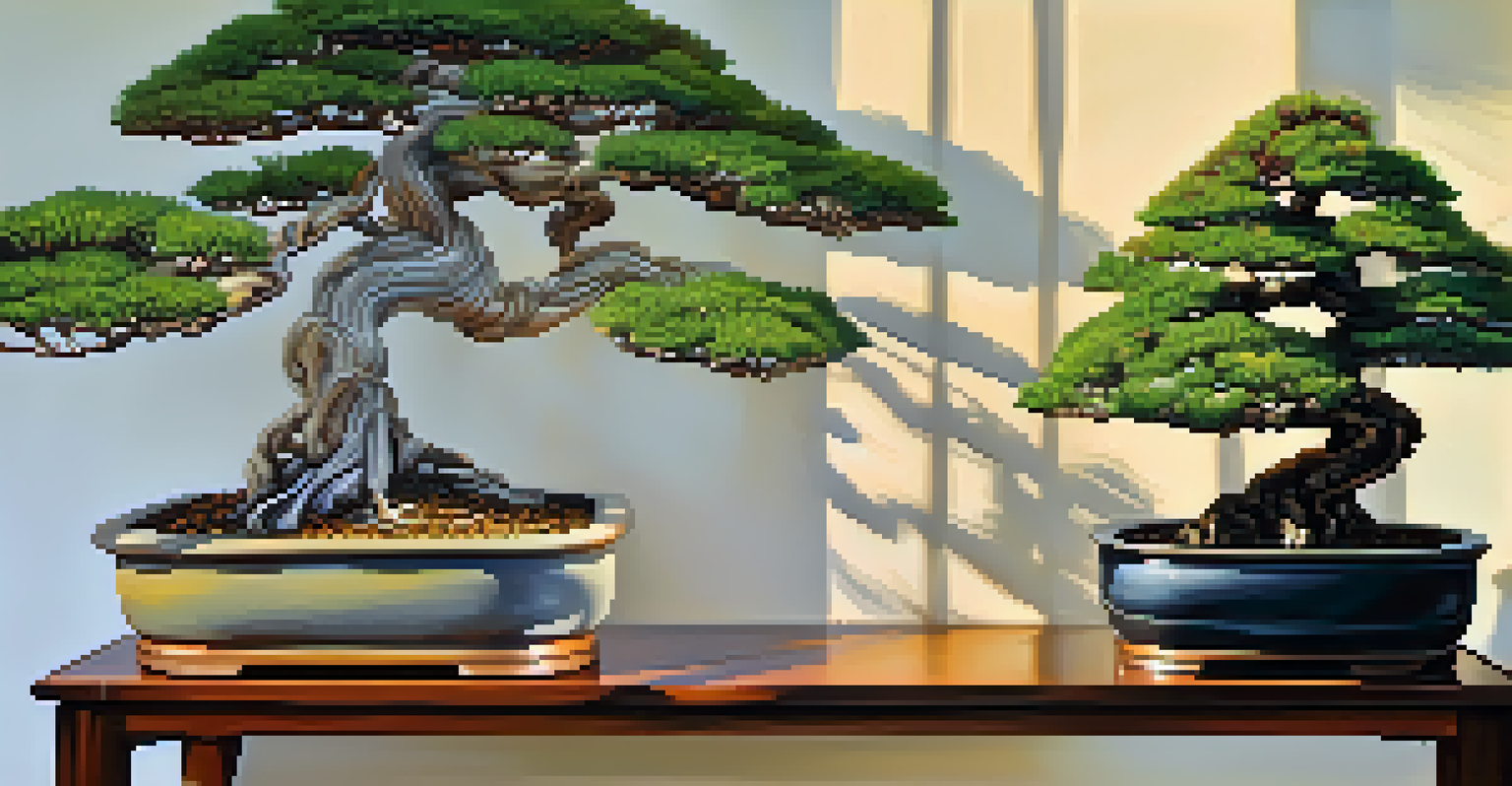Wiring Your Bonsai: Techniques for Design and Growth

Understanding the Basics of Bonsai Wiring
Wiring is a fundamental technique in bonsai cultivation that helps shape and position branches. It involves wrapping a thin wire around the branches and trunk to guide their growth in a desired direction. Understanding the structure and flexibility of your bonsai species is crucial before you begin, as some trees are more pliable than others.
The art of bonsai is to create a miniature tree that looks like a full-sized tree in nature.
The goal of wiring is to promote an aesthetically pleasing form while ensuring the health of your tree. By bending branches and trunks, you can create a more dynamic and visually interesting silhouette. Just like a sculptor chisels away at a block of marble, you’re shaping your bonsai into a work of art.
It's essential to approach wiring with patience and care. Improper wiring can cause damage to the bark or impede growth, so take your time to assess and adjust as needed. Remember, the journey of shaping your bonsai is just as important as the final result.
Choosing the Right Wire for Your Bonsai
Selecting the appropriate wire is crucial for effective bonsai wiring. Typically, aluminum and copper wires are used, with aluminum being more beginner-friendly due to its flexibility. Copper wire, while stronger, requires more skill to manipulate but offers excellent support for heavier branches.

When choosing wire thickness, a general rule of thumb is to use wire that is one-third the thickness of the branch you intend to wire. This ensures enough strength to hold the shape without causing damage. Think of it like choosing the right size shoe; it needs to fit just right to be comfortable and effective.
Wiring Shapes Your Bonsai's Growth
Wiring is a crucial technique that guides your bonsai's branches into an aesthetically pleasing form while ensuring its health.
Additionally, consider the aesthetic aspect of the wire. While it will eventually be removed, using a wire that blends in with the tree can help maintain the beauty of your bonsai’s appearance during the training process. Take your time to select the best option to suit your tree's needs.
Preparing Your Bonsai for Wiring
Before you begin wiring, it's essential to prepare your bonsai properly. Start by inspecting your tree for any damaged or unhealthy branches, as these should be trimmed away first. This not only enhances the tree's overall health but also provides a clearer canvas for your wiring efforts.
Just as a sculptor shapes his statue, so does the bonsai artist shape the tree.
Next, consider the time of year; late spring or early summer is typically the best time to wire your bonsai, as this is when the tree is actively growing. The increased flexibility of the branches during this period makes it easier to shape them without causing harm. Think of it as catching a wave at the perfect moment; timing is everything.
Finally, make sure your tools are clean and ready to use. Sharp pruning scissors and quality wire cutters will make the process smoother, allowing you to work efficiently. A well-prepared bonsai and workspace can make all the difference in achieving your design goals.
Techniques for Wiring Your Bonsai
When it comes to wiring your bonsai, there are several techniques to consider. The most common method involves wrapping the wire around the branch in a spiral pattern, starting from the base and moving upwards. This technique allows for gradual bends and curves, giving you greater control over the shape of the branch.
Another technique is to use the 'double wiring' method, where two wires are used on opposite sides of the branch. This provides additional support, especially for larger branches, and helps maintain the desired position more effectively. It's similar to using a seatbelt while driving; it keeps everything secure and in place.
Choose the Right Wire Thickness
Using the correct wire thickness, ideally one-third the size of the branch, is essential to avoid damage and provide proper support.
As you wire, remember to check frequently for signs of stress on the branches. If you notice any signs of pinching or damage, adjust the wire or remove it as necessary. The goal is to encourage growth and shape while keeping your tree healthy and thriving.
When to Remove the Wiring from Your Bonsai
Knowing when to remove the wiring is just as important as the wiring process itself. Typically, wires should be left on for about six months, but this can vary based on the species and growth rate of your bonsai. Regularly check the wires for signs of cutting into the bark, which can occur if they’re left on too long.
As a rule of thumb, if the branch has taken on the desired shape and the wire begins to dig into the bark, it's time to remove it. A gentle touch is key; you don’t want to cause any unnecessary stress or damage to the tree. Think of it like a friendship; sometimes you have to know when to let go.
Once the wire is removed, it's a good opportunity to assess the overall shape and make any further adjustments if needed. With careful monitoring, your bonsai will continue to thrive in its new form, showcasing the beauty of your efforts.
Caring for Your Wired Bonsai
After wiring your bonsai, ongoing care is essential to ensure it remains healthy. Regularly check for any signs of stress or damage to the branches and adjust your watering and feeding regimen as needed. Keeping your bonsai hydrated and well-nourished will support its recovery and growth.
It's also important to be cautious when handling your bonsai during this period. Avoid moving it around too much, as this can disturb the branches and undo your careful wiring. Think of it like nurturing a seedling; stability and care are vital for its development.
Care After Wiring is Essential
Ongoing care and regular monitoring after wiring are vital to ensure your bonsai remains healthy and continues to thrive.
Lastly, keep observing your bonsai as it grows. Each tree is unique and may require different levels of attention. By staying engaged and responsive to your bonsai's needs, you will foster a strong and beautiful tree that reflects your dedication.
Common Mistakes to Avoid When Wiring
Even experienced bonsai enthusiasts can make mistakes while wiring. One common error is using wire that is too thick, which can damage the branches rather than support them. Always remember the guideline of one-third the thickness of the branch to avoid this pitfall.
Another frequent mistake is leaving the wire on for too long, which can lead to scarring or even death of the branch. Regularly monitor the growth and health of your bonsai to determine the right time for removal. Just as with any project, knowing when to step back is essential.

Lastly, avoid over-wiring your bonsai. It’s easy to get carried away with creative ideas, but too much wire can overwhelm the tree and hinder its natural growth. Embrace simplicity, and let your bonsai's unique character shine through in your design.